areas of the world that were ever part of the British Empire. Current British Overseas TerritoAll ries have their names underlined in red.
The Sun Never Set on the British Empire’s Oppression
Leaders in Myanmar, Hong Kong, and India see no issue in blaming former colonial overlords while using their repressive laws.
Timothy McLaughlin
Late last month, the leader of Myanmar’s junta, Min Aung Hlaing, stood on a huge parade field to recount the military’s “immense prestige etched in the annals of history.” Hundreds of soldiers who had not been deployed to quell an uprising against the country’s coup marched in formation at dawn. Armored vehicles spewing black smoke rumbled alongside them.
The speech marked Myanmar’s annual Armed Forces Day, telling a soaring and selectively edited tale of the institution’s “glorious past.” As in most retellings of the country’s recent history, special attention was paid to the wrongdoings of its former colonial master and the way the military “annihilated the British Imperialists.” Indeed, Myanmar (also known as Burma) might have won independence in 1948, but almost all of the country’s ills—real and perceived—are still regularly blamed on the British.
Yet that disdain is not quite enough to do away with the onerous laws Britain left behind: Successive Burmese governments have shown a fondness for wielding them to silence critics and quash dissent—and Min Aung Hlaing has proved no different. Five days after his speech, his regime charged Aung San Suu Kyi, the country’s de facto leader, who has been detained since the February 1 coup, under the Official Secrets Act. The law dates from 1923 and covers a plethora of offenses, including trespassing and possessing documents deemed secret. It carries a maximum sentence of 14 years in prison.
Recommended Reading
Across Asia, in places such as Myanmar, India, and Hong Kong, leaders that espouse nationalist rhetoric and bemoan their former colonial overlords see no issue with deploying laws designed by those foreign masters against their own people. These lasting vestiges of the British empire are draconian, overly broad, and vaguely worded, but they persist very much because of these traits, existing as powerful weapons of modern lawfare. In fact, rather than repealing them, some governments have tweaked and fused them with new rules, creating even more problematic regulations.
“Any government would want these laws to remain so that they could use it whenever politically convenient for them, and to silence dissenters,” Chitranshul Sinha, a lawyer and the author of The Great Repression: The Story of Sedition in India, told me of that country’s colonial legal legacy. “These laws cause a chilling effect on free speech—that archnemesis of authoritarians.”
Democratic and quasi-democratic postcolonial governments in Asia have for decades avoided abolishing or significantly reforming such laws, including Myanmar’s Official Secrets Act, sedition laws in India and Hong Kong, and a host of other colonial-era regulations, despite ample warnings about possible future misuse. In 1997, months before Britain returned Hong Kong to China, the late legal scholar Ming Kou Chan assessed the much-praised legal system that would be left behind when the Union Jack was lowered. “Despite British claims that they brought the blessings of the rule of law to Hong Kong, as in many other colonies,” he wrote, “the British have in fact created a legal system emphasizing law and order while neglecting the personal liberties and individual rights associated with the common law tradition.”
In Myanmar, the military—which in an effort at legitimacy has named itself the State Administration Council—has made liberal use of these outdated laws. Although Suu Kyi’s case has drawn the most attention, the junta makes almost nightly pronouncements through state television and radio of new arrest warrants targeting journalists, activists, models, and medical workers, all issued under a section of the country’s 1861 penal code that has long been criticized by activists and rights groups for criminalizing speech. (The military tweaked a portion of the law following its seizure of power, making possible the punishment of those who question the legitimacy of the coup or the military government.)
Among those at risk is Myat Noe Aye, a well-known actor and influencer who used her substantial social-media following to rally support for anti-coup demonstrations and document her own attendance at protests. This month, the 25-year-old saw her picture on TV alongside those of others accused of incitement. Seemingly unperturbed by the possibility of imprisonment, she turned to Facebook to do a bit of quick trolling, posting a screenshot of the broadcast with the caption “Thank you for using a beautiful photo” and a kissy-face emoji. “They want people to be afraid of them, to make them feel like they are powerful,” she told me of the junta. To do this, she said, they had resorted to their old tactics, using “stupid” laws, communications cuts, and arbitrary killings. But, she said, “we are living in the 21st century; they can’t scare us easily.”
None of Myanmar's past governments, including those elected during its period of limited democracy from 2012 through February, made serious efforts to substantively amend or abolish the Official Secrets Act or similar laws. If anything, those administrations used them to their advantage, too. In 2018, two Reuters journalists were charged with violating the Official Secrets Act for reporting on the massacre of a group of Rohingya men. Suu Kyi, whose “rule of law” refrain made at least a cameo in nearly all of her public addresses, defended the jailings both publicly and privately. When the pair—with whom I worked while I was posted to Myanmar for Reuters—were handed seven-year sentences, she explained dryly that their punishment was not repressive. “I wonder whether many people have actually read the summary of the judgment, which had nothing to do with the freedom of expression at all; it had to do with the Officials Secrets Act,” she told a forum audience in Hanoi. (The lawyer who defended the Reuters duo is now defending Suu Kyi.)
Read: How Aung San Suu Kyi lost her way
Her stance was much the same as that of the previous administration, the first after direct military rule ended, which used the act against four journalists and the chief executive of a local newspaper, Unity Journal. The paper had printed a report claiming that a defense facility was really a chemical-weapons factory. The government denied the story, which was poorly sourced and written, and all five defendants were sentenced to 10 years in jail with hard labor, though they were later released. Daniel Aguirre, a senior lecturer in law at the University of Roehampton in the U.K., who previously served as the legal adviser for the International Commission of Jurists in Myanmar, says laws such as the Official Secrets Act were created “to control colonial subjects and ensure stability for colonial economic exploitation.” What they were not designed to do, he told me, was “protect the human rights of citizens. That these laws have been maintained by successive governments since independence reflects governance that values stability and tranquility over human rights and freedoms.”
Restoring stability has become the guiding principle of Carrie Lam, Hong Kong’s chief executive, after she helped kick-start prodemocracy protests in 2019. She has relied on colonial-era emergency ordinances, and sedition cases have reappeared in Hong Kong courts, more than a decade after Britain abolished the offense. In 2009, a British official said that the law had hailed “from a bygone era when freedom of expression wasn’t seen as the right it is today,” and expressed hope that other countries where similar statutes were still enforced would follow suit. Even before the protests began, Lam’s government showed that it was content to reach into the past to achieve its goals, using a public-security ordinance from 1911 to ban a fringe political group in 2018, a first since the territory had been returned to China. More recently, the city’s authorities have combined pre-handover laws with new legislation aimed at quashing dissent, under the guise of maintaining security.
At the same time, the government has been stripping away mentions of colonialism from city museums as it looks to revise its history, according to local media. (It has no issue, however, with the British officers still serving in its police force’s ranks.) Pro-Beijing figures, always in search of targets to blame for their own low popularity and poor governance record, have argued that colonialism is responsible for a lack of national identity in Hong Kong. More bellicose rhetoric has come from Beijing officials who have used colonialism as a cudgel, consistently decrying Britain’s meddling. During the height of the 2019 protests, a former Chinese ambassador to London claimed that his host country had a “colonial mindset” regarding Hong Kong, which had been under British rule for 156 years. And this year, a spokesperson for the Chinese foreign ministry pointed out that the British had “imposed draconian restrictions on assembly, procession, and association in Hong Kong.” Ronny Tong, a prodemocracy lawmaker turned vociferous establishment cheerleader, who is now part of Lam’s cabinet, made a similar case to me. He argued that Beijing’s all-encompassing national-security law, used to arrest dozens of people and a key piece of the city’s reengineering, was actually an improvement on the colonial-era Crimes Ordinance.
Senia Ng, a barrister and member of Hong Kong’s biggest prodemocracy party, told me that the issue was not just the continued existence of such laws, but the manner in which the government was using them. “The government tries to get rid of Hong Kong’s colonial roots, but still deploys it when they find it useful,” Ng said. “At the end of the day, I think it boils down to prosecuting for political motives.” As an example, many in the prodemocracy movement point to a group of prominent activists including Martin Lee, the city’s octogenarian “Father of Democracy,” and the media tycoon Jimmy Lai, who will be sentenced on Friday for violating the Public Order Ordinance, a series of regulations enacted in 1967 to empower police during leftist riots fueled by the Cultural Revolution. The group faces five years in jail for taking part in a peaceful march that drew more than 1.5 million people to Hong Kong’s rain-soaked streets two years ago.
Read: China is the Myanmar coup’s ‘biggest loser’
Similar moves can be seen in India, where the case of Disha Ravi, a 22-year-old climate activist charged in February with sedition, brought renewed global attention to the suppression of free speech under Prime Minister Narendra Modi’s Hindu nationalist government. The charges against Ravi stem from her compiling and sharing a document to help farmers protest against agricultural laws.
Sinha, the lawyer and author, told me the use of sedition laws in India is “downright oppressive” and “most definitely hypocritical.” Much as it does elsewhere, it “sort of mirrors the way the British handled dissent.”




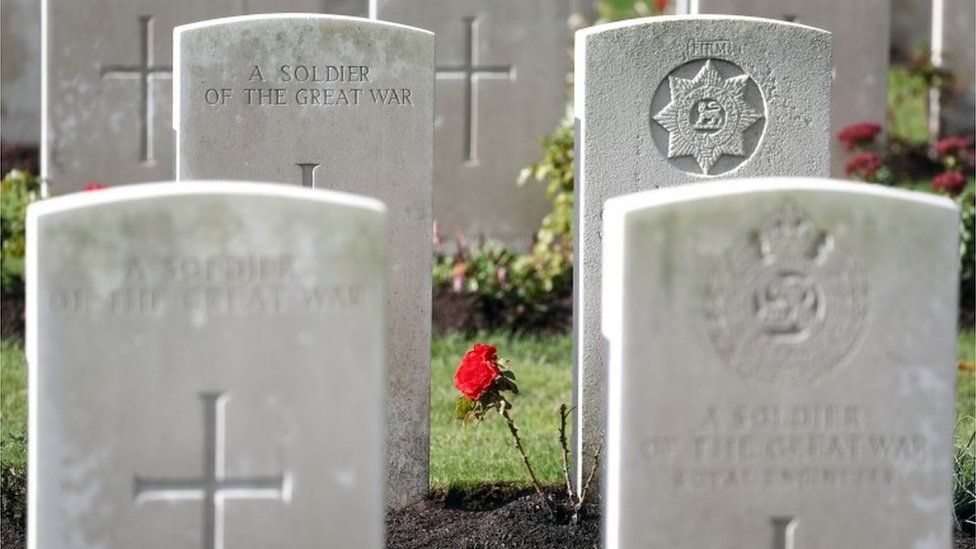

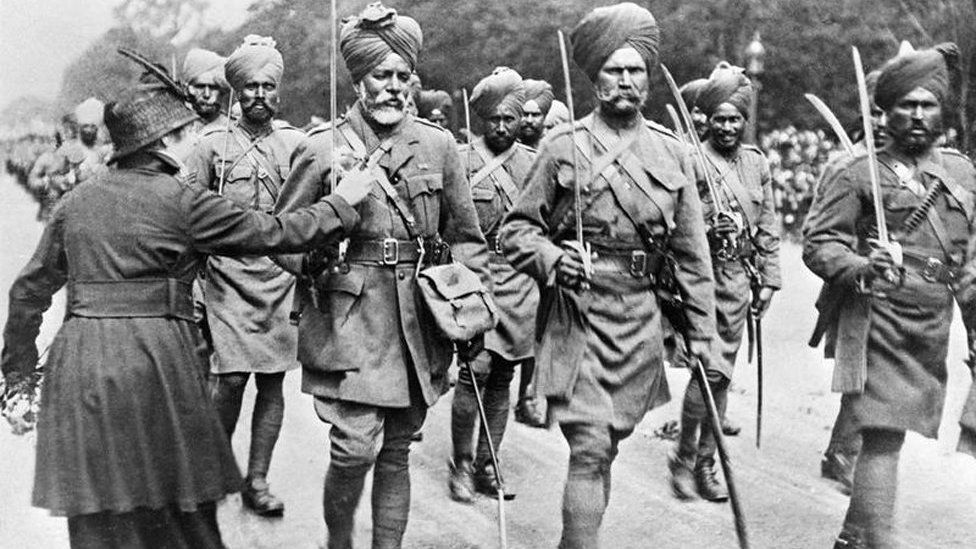





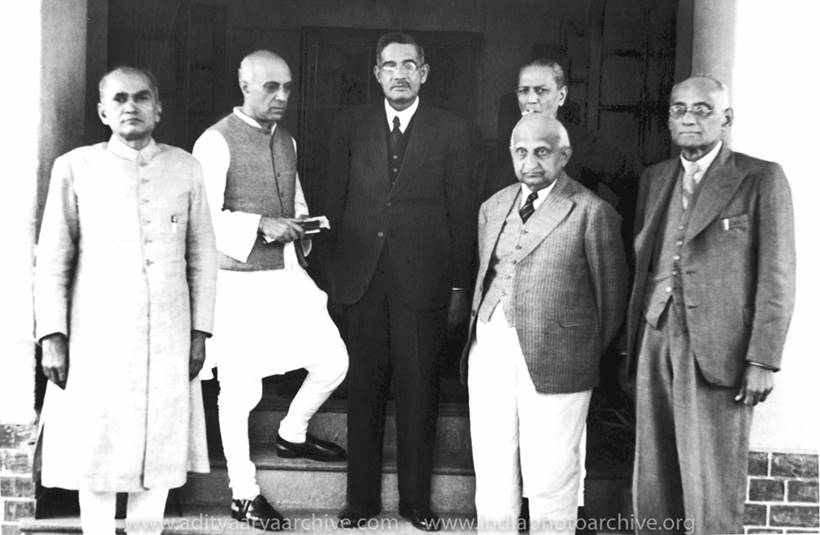 Jawaharlal Nehru with the members of the INA Defence Committee,
1945. Photo by Kulwant Roy (1914-1984) and photo credit : Aditya Arya
Archives, Chairman & Trustee, India Photo Archive Foundation.
Jawaharlal Nehru with the members of the INA Defence Committee,
1945. Photo by Kulwant Roy (1914-1984) and photo credit : Aditya Arya
Archives, Chairman & Trustee, India Photo Archive Foundation. Members of the Defence Committee, R.B. Badri Dass, Justice Acchru Ram
and Asaf Ali discussing the charge sheet of the INA cadre at Delhi Red
Fort, 1945. Photo by Kulwant Roy (1914-1984) and photo credit : Aditya
Arya Archives, Chairman & Trustee, India Photo Archive Foundation.
Members of the Defence Committee, R.B. Badri Dass, Justice Acchru Ram
and Asaf Ali discussing the charge sheet of the INA cadre at Delhi Red
Fort, 1945. Photo by Kulwant Roy (1914-1984) and photo credit : Aditya
Arya Archives, Chairman & Trustee, India Photo Archive Foundation.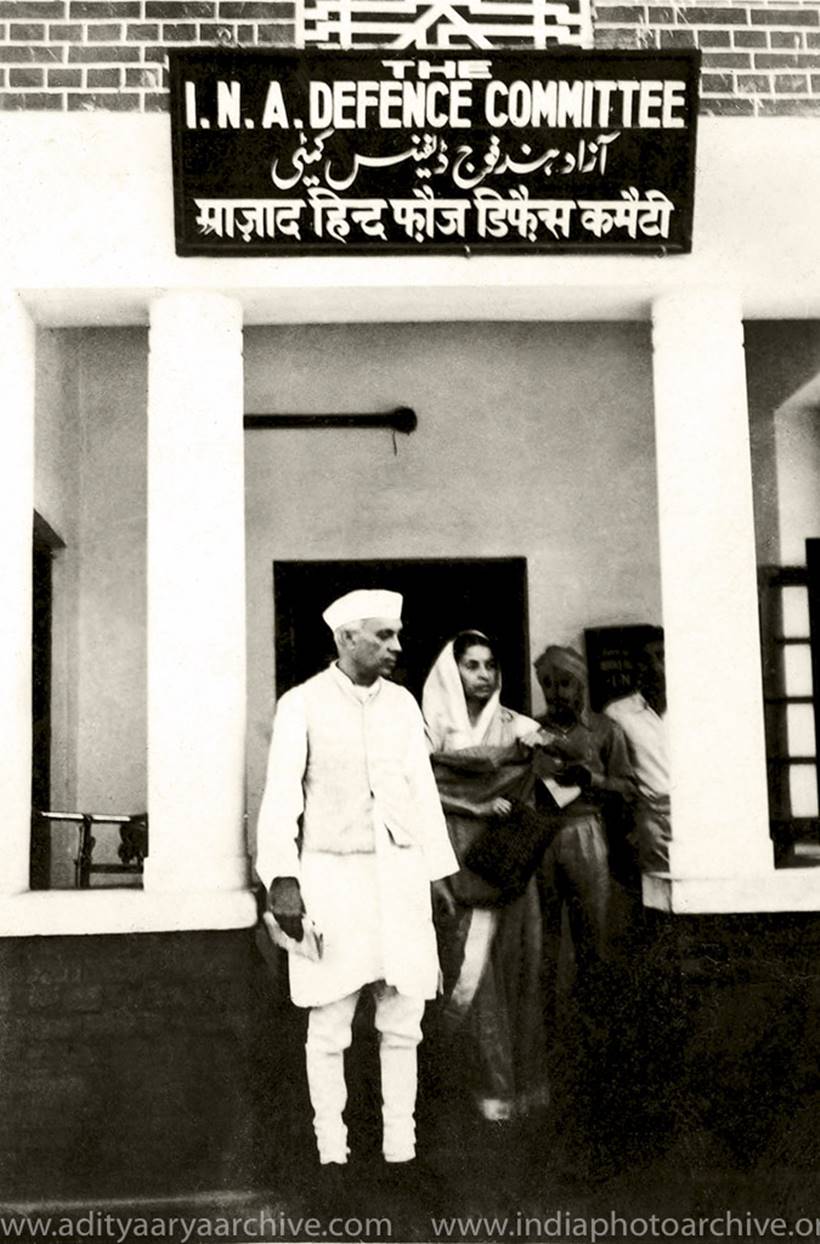 Jawaharlal Nehru emerging from the Defence Committee office. Photo by
Kulwant Roy (1914-1984) and photo credit : Aditya Arya Archives,
Chairman & Trustee, India Photo Archive Foundation.
Jawaharlal Nehru emerging from the Defence Committee office. Photo by
Kulwant Roy (1914-1984) and photo credit : Aditya Arya Archives,
Chairman & Trustee, India Photo Archive Foundation. General Mohan Singh who formed the First I.N.A in Far East is seen here
while chatting with Mrs. Ehsan Qadir, wife of Capt. Ehsan Qadir of the
INA. Photo by Kulwant Roy (1914-1984) and photo credit : Aditya Arya
Archives, Chairman & Trustee, India Photo Archive Foundation.
General Mohan Singh who formed the First I.N.A in Far East is seen here
while chatting with Mrs. Ehsan Qadir, wife of Capt. Ehsan Qadir of the
INA. Photo by Kulwant Roy (1914-1984) and photo credit : Aditya Arya
Archives, Chairman & Trustee, India Photo Archive Foundation.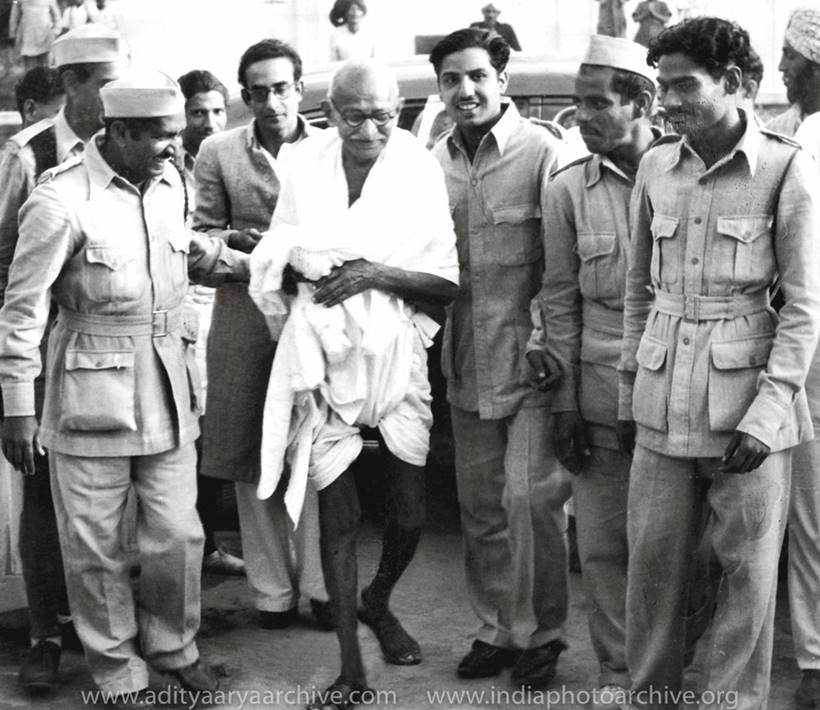 Mahatma Gandhi with soldiers of the INA, 1945. Photo by Kulwant Roy
(1914-1984) and photo credit : Aditya Arya Archives, Chairman &
Trustee, India Photo Archive Foundation.
Mahatma Gandhi with soldiers of the INA, 1945. Photo by Kulwant Roy
(1914-1984) and photo credit : Aditya Arya Archives, Chairman &
Trustee, India Photo Archive Foundation.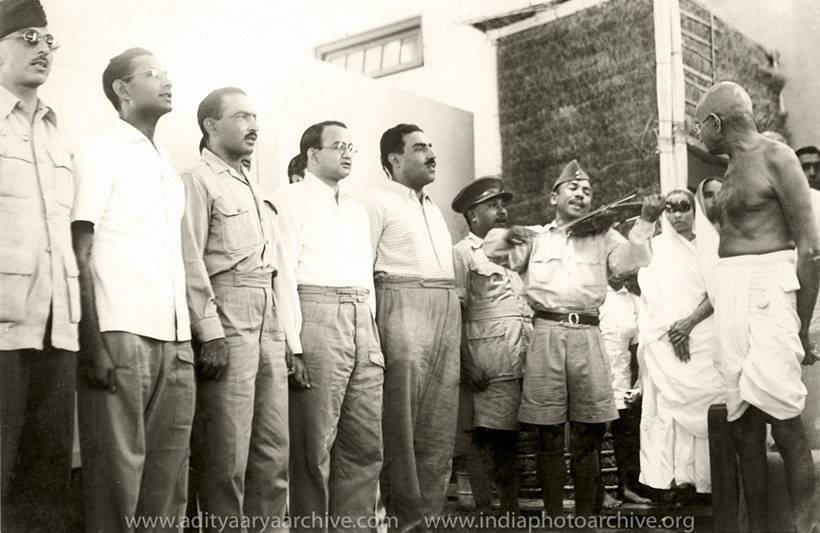 Captain Ram Singh, who had composed the patriotic song ‘Kadam Kadam
Badhaye Ja’ plays the violin for Gandhiji at the Harijan Colony,
1945. Photo by Kulwant Roy (1914-1984) and photo credit : Aditya Arya
Archives, Chairman & Trustee, India Photo Archive Foundation.
Captain Ram Singh, who had composed the patriotic song ‘Kadam Kadam
Badhaye Ja’ plays the violin for Gandhiji at the Harijan Colony,
1945. Photo by Kulwant Roy (1914-1984) and photo credit : Aditya Arya
Archives, Chairman & Trustee, India Photo Archive Foundation.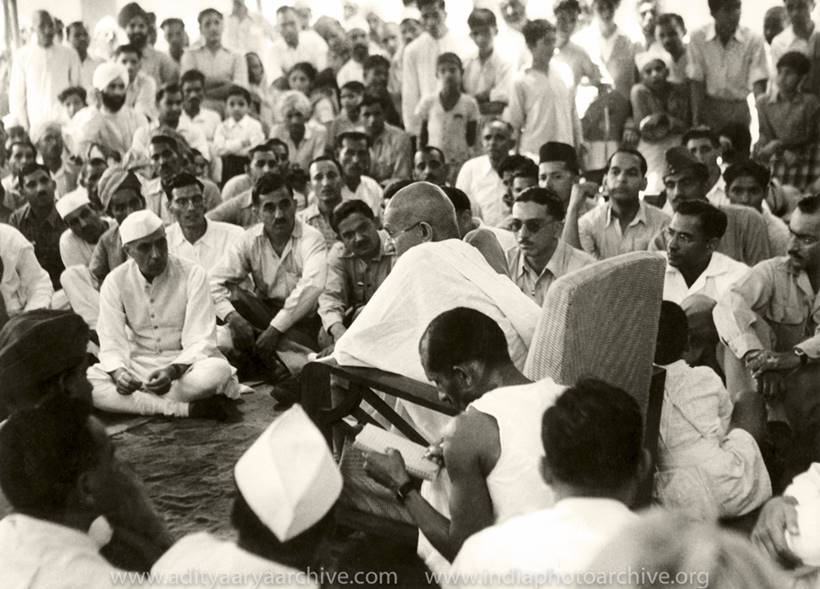 Jawaharlal Nehru attends a meeting of Gandhiji and INA soldiers,
1945. Photo by Kulwant Roy (1914-1984) and photo credit : Aditya Arya
Archives, Chairman & Trustee, India Photo Archive Foundation.
Jawaharlal Nehru attends a meeting of Gandhiji and INA soldiers,
1945. Photo by Kulwant Roy (1914-1984) and photo credit : Aditya Arya
Archives, Chairman & Trustee, India Photo Archive Foundation.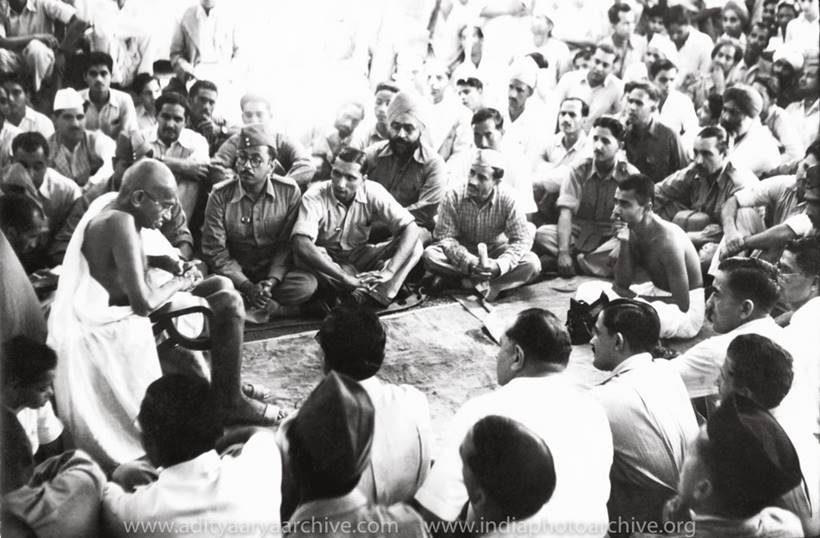 An engrossed audience listening to Gandhiji in this rare documentation
of the meeting, 1945. Photo by Kulwant Roy (1914-1984) and photo credit :
Aditya Arya Archives, Chairman & Trustee, India Photo Archive
Foundation.
An engrossed audience listening to Gandhiji in this rare documentation
of the meeting, 1945. Photo by Kulwant Roy (1914-1984) and photo credit :
Aditya Arya Archives, Chairman & Trustee, India Photo Archive
Foundation.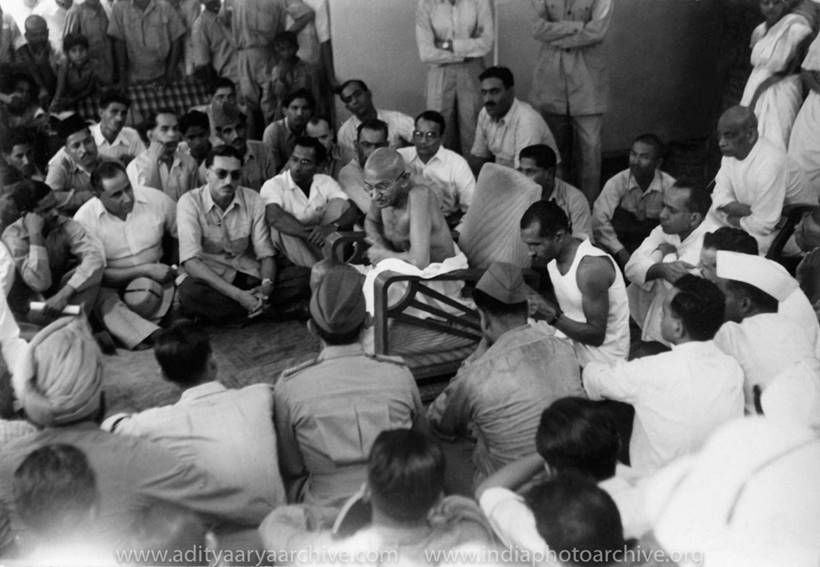 Also seen attending the meeting is Sardar Patel, 1945. Photo by Kulwant
Roy (1914-1984) and photo credit : Aditya Arya Archives, Chairman &
Trustee, India Photo Archive Foundation.
Also seen attending the meeting is Sardar Patel, 1945. Photo by Kulwant
Roy (1914-1984) and photo credit : Aditya Arya Archives, Chairman &
Trustee, India Photo Archive Foundation.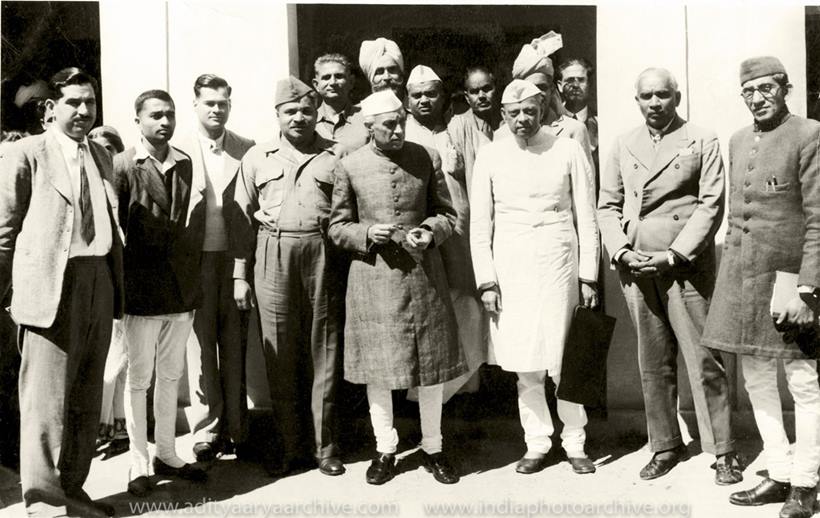 Jawaharlal Nehru with members of the INA enquiry committee at the
Constitution Club, New Delhi (1945). Photo by Kulwant Roy (1914-1984)
and photo credit : Aditya Arya Archives, Chairman & Trustee, India
Photo Archive Foundation.
Jawaharlal Nehru with members of the INA enquiry committee at the
Constitution Club, New Delhi (1945). Photo by Kulwant Roy (1914-1984)
and photo credit : Aditya Arya Archives, Chairman & Trustee, India
Photo Archive Foundation.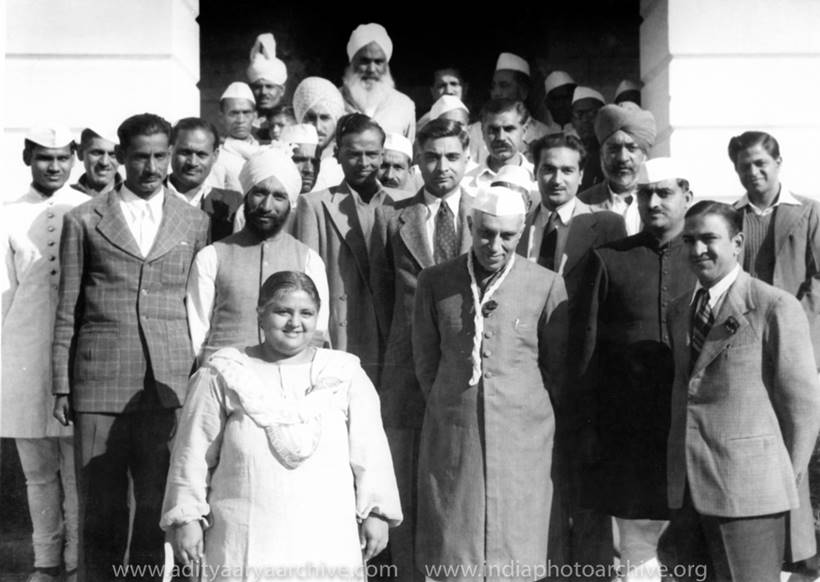 Jawaharlal Nehru with INA cadre, 1945. Photo by Kulwant Roy (1914-1984)
and photo credit : Aditya Arya Archives, Chairman & Trustee, India
Photo Archive Foundation.
Jawaharlal Nehru with INA cadre, 1945. Photo by Kulwant Roy (1914-1984)
and photo credit : Aditya Arya Archives, Chairman & Trustee, India
Photo Archive Foundation.